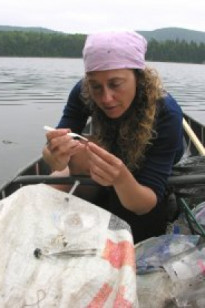

Dr. Kolozsvary has worked in various aspects of wildlife and aquatic biology research and management. She has extensive experience contributing, building, and cooperatively leading partnerships among a variety of constituencies in biodiversity conservation. As a biodiversity scientist for the New York State Biodiversity Research Institute (BRI), where she served as scientific liaison to the BRI’s scientific working group for 6 years, she worked with other expert scientists to identify priorities for biodiversity, conservation, and educational projects in New York State. She served as an expert participant and reviewer of many projects and regional conservation initiatives, such as New York State’s Comprehensive Wildlife Conservation Strategy and several of their watershed action plans. She also served as an active participant in the Eastern Chapter of The Nature Conservancy’s Hudson River Estuary Watershed conservation planning initiative. She has been instrumental in creating and fostering networks of scientific experts, through working groups, coordinating symposia and conferences, and partnering with regional organizations. She has also led and partnered with other agencies and non-governmental organizations to produce exhibits designed to educate the public about biodiversity science and issues affecting its conservation.
| Degree | Program | University |
|---|---|---|
| Ph.D. | University of Maine | |
| M.S. | Purdue University | |
| B.S. | SUNY College of Environmental Science and Forestry |
My Siena Experience
My Teaching Philosophy
My approach to teaching is to recognize the diversity of ability of students in a classroom, and teach to the particular class before me. I aim for the top of class abilities, but will not let the rest of the students falter when I do. By aiming for the top, yet continually checking in on and pulling in the class as a whole, I am able to challenge all the students and better prepare them for success in their academic and post-Siena lives.
What I Love About Siena
I love the small class sizes and the opportunity to connect with the students. It is rewarding to see how green the students are when they first start in the program and then see them as seniors, about to embark into their next adventure in life. The change is remarkable and I like to know I have been instrumental in that transformation.
My Favorite Courses to Teach
- Environmental Science
- Conservation Biology
- Principles of Ecology
- Winter Field Ecology (Who doesn't love snow!?!?)
My Professional Experience
Articles & Book Reviews
- Flexible and inclusive ecology projects that harness collaboration and NEON-enabled science to enhance student learning
Ecological Society of America Bulletin, vol. 103
2022 - Where is garlic mustard? Understanding the ecological context for invasions of Alliaria petiolata
BioScience, vol. 72
2022 - Developing a flexible learning activity on biodiversity and spatial scale concepts using open-access vegetation datasets from the National Ecological Observatory Network
Ecology and Evolution
2021 - Toward a universal theoretical framework to understand robustness and resilience: from cells to systems
Frontiers in Ecology and Evolution
2021 - A broader approach to understanding urbanization effects on freshwater turtles: reply to Lambert and Steen 2019
Conservation Biology: The Journal of the Society for Conservation Biology, vol. 33
2019 - Effects of urbanization on the population structure of freshwater turtles across the United States
Conservation Biology: The Journal of the Society for Conservation Biology, vol. 32
2018 - Expert perceptions of approaches to protecting isolated wetlands in the northeastern United States
Journal of the American Water Resources Association (JAWRA)
2017 - The role of landsurface versus drainage network characteristics in controlling water quality and quantity in a small urban watershed
Hydrological Processes, vol. 31
2017 - Creating temporary pools as wetland mitigation: how well do they function?
Wetlands, vol. 36
2016 - Presence of ranavirus in a created temporary pool complex in southeastern New York, USA
Herpetological Review, vol. 47
2016 - Ranaviruses in vernal pool amphibian die‐offs in New York State
Herpetological Review, vol. 42
2011 - Responses of "resistant" vertebrates to habitat loss and fragmentation: the importance of niche breadth and range boundaries
Diversity and Distributions, vol. 9
2003 - The scope and treatment of threats in endangered species recovery plans
Ecological Applications, vol. 12
2002 - Habitat fragmentation and the distribution of amphibians: patch and landscape correlates in farmland
Canadian Journal of Zoology, vol. 77
1999
Books & Book Chapters
- Inventory and Monitoring: Recommended Techniques for Reptiles and Amphibians, with application to the United States and Canada
Partners in Amphibian and Reptile Conservation
2013 - Legacy: Conserving New York State's Biodiversity
American Museum of Natural History, NYS Biodiversity Research Institute, NYS Dept Environ Conserv, New York Natural Heritage Program, and The Nature Conservancy
2006